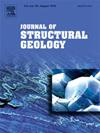透辉石中的残余应力:对挪威罗弗敦下地壳发震断层中局部瞬态高应力的洞察
IF 2.9
2区 地球科学
Q2 GEOSCIENCES, MULTIDISCIPLINARY
引用次数: 0
摘要
挪威罗弗敦群岛的变质斜长岩中的伪长岩保存了在650-750°C和0.8 GPa的温度和压力下干燥的下地壳地震破裂的记录。微观结构证据表明存在瞬时千兆帕斯卡级应力,但这种高应力尚未被量化。在这篇论文中,我们利用高角分辨率电子背散射衍射(HR-EBSD)技术,将显微结构分析与从Nusfjord (Lofoten)的下地壳伪石中提取的辉石中残余应力的非均质性映射结合起来。我们的目的是阐明导致这种残余应力的变形过程及其在透辉石晶粒中的空间异质性。透辉石在断层3毫米范围内和假岩中的碎屑中含有微至纳米级的变形孪晶。在碎屑内部,透辉石晶格强烈起伏,表明在高驱动应力下晶体具有可塑性。残余应力不均匀性范围在~ 200 MPa和~ 800 MPa之间的平面内正应力,较大的值发生在靠近假羟基的地方。这种趋势对于面内剪切应力不明显,其残余应力在~ 150和~ 250 MPa之间具有非均质性,与断层距离无关。最大的残余应力存在于由位错滑动引起的晶格畸变的碎屑中。机械孪晶、晶格波动和残余应力分布模式被同震断裂截断,表明微观结构和残余应力是滑移前应力积累的结果。考虑到残余应力不均匀性的极端空间局部化,我们得出结论,这是地震破裂传播过程中发生的变形造成的。尽管在摩擦加热过程中温度很高,但热压力对残余应力的贡献并不显著。透辉石作为应力记录仪的行为受到机械孪晶的影响:透辉石中的应力积累可能因孪晶的形成而部分消散,孪晶也似乎影响残余应力,特别是剪切应力。本文章由计算机程序翻译,如有差异,请以英文原文为准。
Residual stress in diopside: insight into localized transient high stress in seismogenic faults in the lower crust, Lofoten, Norway
Pseudotachylytes in the metamorphosed anorthosites of the Lofoten archipelago, Norway, preserve a record of seismic rupture in dry lower crust at temperatures and pressures of 650–750 °C and 0.8 GPa. Transient gigapascal-level stresses are suggested from microstructural evidence, however such high stresses have not been quantified. In this contribution, we combine microstructural analysis with the mapping of heterogeneity in residual stress in diopside from a lower-crustal pseudotachylyte from Nusfjord (Lofoten) using high-angular resolution electron backscatter diffraction (HR-EBSD). We aim to elucidate the deformation processes that led to this residual stress and to its spatial heterogeneity in the diopside grains.
The diopside contains micro-to nanoscale deformation twins within 3 mm of the fault and in clasts in the pseudotachylyte. Within clasts, the diopside lattice strongly undulates, indicating crystal plasticity at high driving stress. Residual stress heterogeneity ranges between ∼200 MPa and ∼800 MPa for in-plane normal stress, with greater values occurring closer to and in the pseudotachylyte. This trend is not apparent for the in-plane shear stress, which has residual stress heterogeneity between ∼150 and ∼250 MPa, not correlating with distance to the fault. The greatest residual stresses are present in a clast that exhibits lattice distortion resulting from dislocation glide. Mechanical twins, lattice undulations, and the distribution patterns of residual stress are truncated by coseismic fractures, suggesting that the microstructures and residual stress are the result of stress build-up prior to slip.
Given the extreme spatial localization of the residual stress heterogeneity, we conclude that it results from deformation occurring during earthquake rupture propagation. Despite high temperatures during frictional heating, thermal pressure did not contribute significantly to the residual stress. The behaviour of diopside as a stress recorder is influenced by mechanical twins: stress build-up in diopside may have partially dissipated by the formation of twins, and twins also appear to affect the residual stress, in particular shear stress.
求助全文
通过发布文献求助,成功后即可免费获取论文全文。
去求助
来源期刊

Journal of Structural Geology
地学-地球科学综合
CiteScore
6.00
自引率
19.40%
发文量
192
审稿时长
15.7 weeks
期刊介绍:
The Journal of Structural Geology publishes process-oriented investigations about structural geology using appropriate combinations of analog and digital field data, seismic reflection data, satellite-derived data, geometric analysis, kinematic analysis, laboratory experiments, computer visualizations, and analogue or numerical modelling on all scales. Contributions are encouraged to draw perspectives from rheology, rock mechanics, geophysics,metamorphism, sedimentology, petroleum geology, economic geology, geodynamics, planetary geology, tectonics and neotectonics to provide a more powerful understanding of deformation processes and systems. Given the visual nature of the discipline, supplementary materials that portray the data and analysis in 3-D or quasi 3-D manners, including the use of videos, and/or graphical abstracts can significantly strengthen the impact of contributions.
 求助内容:
求助内容: 应助结果提醒方式:
应助结果提醒方式:


